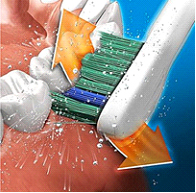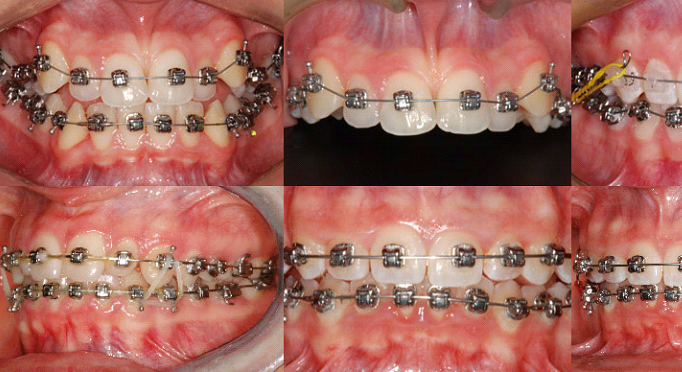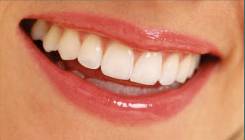White spots on teeth are sometimes occurring naturally or may result from taking certain products such as fluoride. Too much fluoride can cause dental fluorosis which is characterized by the appearance of stains or colored spots on the teeth. Although fixed orthodontic appliances (braces) may contribute to food and plaque retention, it is possible to maintain your teeth and appliances clean during orthodontic treatment with a good dental hygiene and following certain basic “rules”.
Some facts about dental hygiene and orthodontics:
Orthodontic braces themselves do not cause tooth decay, decalcification or gum disease but can help retain food particles and plaque.
- Caries and decalcification spots are due to the action of bacteria in the dental plaque that accumulates on the tooth surfaces.
- Unless these debris are completely removed, problems such as decalcification or discoloration of the teeth and gum infections may arise.
- Decalcification spots, which appear as white spots on teeth, can progress to become caries if oral hygiene is not improved.
- Although some variation may exist in individual susceptibility to decay, the best way to prevent cavities and stains on the teeth is to clean them properly according to the instructions given to you.
- After installing the “braces”, we will give and demonstrate very specific hygiene and brushing instructions and provide you with different types of toothbrushes. You will have all the necessary tools to have an impeccable oral hygiene!
- We recommend and urge you to continue your regular dental visits and cleanings during your orthodontic treatment.

Bacteria in dental plaque adhere to tooth surfaces and can cause tooth decay.
Oral hygiene and brushing techniques
The teeth should be brushed thoroughly after each meal or snack.- A good brushing technique requires time and practice (a good brushing session should be about 2 minutes).
- We recommend using a toothbrush with a small head and soft bristles that are less damaging to the gum.
- Although there are “orthodontic” toothbrushes, any soft brush that is small enough may be adequate.
- It is important to brush with enough pressure to feel the bristles in contact with the gum tissues.
- In some cases, using an electric toothbrush can be an asset. Several models exist on the market but some are more effective than others.
- Ask our staff if you want to try a Sonicare or learn more about ultrasonic or electric toothbrushes.
- The foundation of good dental hygiene is proper tooth brushing but we also encourage you to floss.
- Flossing: It’s harder to floss with braces but we can provide you with threaders and auxiliaries which may facilitate this task.
- Small brush: we will give you small orthodontic brushes made specifically for cleaning areas between the braces and under the wires (Proxabrush).
- If your gums are sensitive or bleed easily during brushing, notify us so that we can assess the cause.

Remember… It is not necessary to brush all your teeth … only those you want to keep!
There are two main reasons why most people have dental hygiene problems, whether or not they have braces: Poor technique: their brushing technique is deficient or inadequate.- They brush long enough (brushing time) but they do not reach to critical areas on the edge of the gums, behind the wires and around the brackets, to remove plaque and food debris.
- It is important to have the bristles contact gently the gums to “massage” them during brushing.
- Make slight twisting, rotative motions on all tooth surfaces.
- Use a vertical motion of the brush head from the gums toward the teeth.
- Do not brush horizontally with a back and forth motion to minimize the chances of tooth and gum wear.
- It is better and less damaging to the gums and teeth to use a toothbrush with soft bristles.
- When in doubt, use a smaller brush head rather than one that is too big.
- Electric toothbrushes can be used but the same basic principles applies (access to areas of plaque accumulation and duration of brushing)
- In certain cases, the brushing technique is adequate but the brushing time is too short to “go around” all the teeth!
- Most experts agree that a proper brushing session should last at least 2 minutes.

 Small flexible brush tips (Proxabrush) make it easier to reach small areas behind the wires and around the brackets to remove dental plaque and food debris.
Small flexible brush tips (Proxabrush) make it easier to reach small areas behind the wires and around the brackets to remove dental plaque and food debris.
 Floss threaders allow you to use dental floss during your orthodontic treatment.
Floss threaders allow you to use dental floss during your orthodontic treatment.
 Severe dental wear caused by very aggressive toothbrushing.
Severe dental wear caused by very aggressive toothbrushing.

What toothbrush to choose?
There exists on the market a wide variety of toothbrushes, each having characteristics acclaimed by manufacturers as being unique, efficient, revolutionary and justifying a a wide price range!
“Regular”" (manual) toothbrushes are available in a many sizes, lengths, shapes and ergonomic designs, with bristles that can be soft, stiff, grouped in clusters, etc.. How can you make sense of all these products and options?
We believe that the most important factors to consider are the size of the brush head and flexibility of the bristles.
- Choose a toothbrush with soft bristles. This will minimize the chances of damaging the gums or the enamel of the teeth if ever your brushing technique is too “aggressive” (see illustration).
- The size of the brush head should allow easy access to all areas of the mouth. It is easier to use a small brush head than a bigger one.
- Adults can easily use toothbrushes made for children but the opposite is not true.
However, brushing technique and consistency to do so are probably more important than the choice of the toothbrush itself.
Good oral hygiene
Examples of excellent oral hygiene during orthodontic treatment
Toutes ces personnes ont une hygiène dentaire pratiquement impeccable et n'auront pas de problèmes d'inflammation, de décaldifications ou de caries pendant leur traitement d'orthodontie. Tout le monde peut avoir un tel résultat avec une bonne technique de brossage.
Problems to avoid
Examples of oral hygiene problems that must be avoided… Crowded teeth are harder to clean and are more prone to plaque ant tartar build-up.
Crowded teeth are harder to clean and are more prone to plaque ant tartar build-up.
 The presence of stains and the accumulation of plaque on these teeth is a sign of poor oral hygiene and is a contra-indication to undertake orthodontic treatment. To avoid problems of tooth decay and decalcification, oral hygiene should be impeccable while wearing braces.
The presence of stains and the accumulation of plaque on these teeth is a sign of poor oral hygiene and is a contra-indication to undertake orthodontic treatment. To avoid problems of tooth decay and decalcification, oral hygiene should be impeccable while wearing braces.
 Accumulation of plaque and food debris on the teeth. Gums are inflamed in some places and bleed easily. Dental hygiene must be improved significantly before beginning orthodontic treatment.
Accumulation of plaque and food debris on the teeth. Gums are inflamed in some places and bleed easily. Dental hygiene must be improved significantly before beginning orthodontic treatment.
 Smokers should pay particular attention to hygiene because nicotine accumulates even in places where there are no brackets or appliances and create tough stains. Coffee, red wine and certain foods may also contribute to the formation of dark spots on the teeth and orthodontic appliances.
Smokers should pay particular attention to hygiene because nicotine accumulates even in places where there are no brackets or appliances and create tough stains. Coffee, red wine and certain foods may also contribute to the formation of dark spots on the teeth and orthodontic appliances.
 This 14 year old girl shows a lot of plaque and gingival inflammation (redness) around the anterior teeth. Her brushing technique is inadequate and will need to improve before starting an orthodontic treatment.
This 14 year old girl shows a lot of plaque and gingival inflammation (redness) around the anterior teeth. Her brushing technique is inadequate and will need to improve before starting an orthodontic treatment.
Under sonstruction / translation
The consequences!
Examples of dental decalcification that occured when hygiene was inadequate during orthodontics. (A) poor hygiene causes a buildup of plaque and food debris. This causes inflammation of the gums (redness) and decalcification of teeth (white spots). (B) Examples of mild decalcification affecting several teeth. (C) Moderate decalcification on some teeth.
(A) poor hygiene causes a buildup of plaque and food debris. This causes inflammation of the gums (redness) and decalcification of teeth (white spots). (B) Examples of mild decalcification affecting several teeth. (C) Moderate decalcification on some teeth.
 (A) Non existant oral care causing a large accumulation of plaque. (B) Areas of moderate decalcification affecting several teeth. (C) Areas of moderate to severe decalcification affecting all teeth. These problems can be avoided with proper brushing technique.
(A) Non existant oral care causing a large accumulation of plaque. (B) Areas of moderate decalcification affecting several teeth. (C) Areas of moderate to severe decalcification affecting all teeth. These problems can be avoided with proper brushing technique.
 Example of damage to teeth during orthodontic treatment due to poor oral hygiene. (C) Carious lesion (arrow).
Example of damage to teeth during orthodontic treatment due to poor oral hygiene. (C) Carious lesion (arrow).
Legend for the picture above:
- (A) Patient demonstrating areas of decalcification before treatment (arrows). Hygiene is not perfect but acceptable.
- (B) During treatment, the situation deteriorates; hygiene (brushing) is problematic, dental plaque builds up around the brackets and gums become red and inflamed.
- (C) At the end of treatment, upon removing the braces, several areas of severe decalcification are visible in both arches. Decay is even visible on a tooth (arrow). The gums are swollen, puffy and have an irregular contour (inflammation). The papillas are thickened. Several white spots of decalcification are visible.
- (D) The patient had some of the cavities repaired on upper incisors. Several other teeth will also need to be repaired. Hygiene has now improved and the gums show more regular contour and a normal color. The papillae are less swollen.
Damage to teeth requiring costly repairs could have been avoided with an impeccable oral hygiene during orthodontic treatment.
Keep visiting your dentist during your orthodontic treatment.
 Decalcification may progress to severe tooth decay or breakdown of the enamel of the tooth (arrows).
All white spots on the teeth are not decalcification. They can occur naturally or be the result of taking certain medications or products. To see examples of dental fluorosis.
Decalcification may progress to severe tooth decay or breakdown of the enamel of the tooth (arrows).
All white spots on the teeth are not decalcification. They can occur naturally or be the result of taking certain medications or products. To see examples of dental fluorosis.












